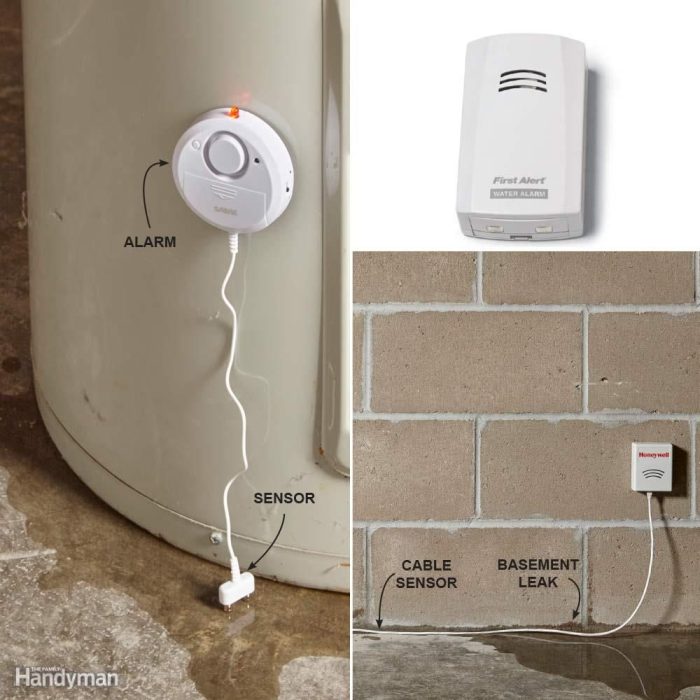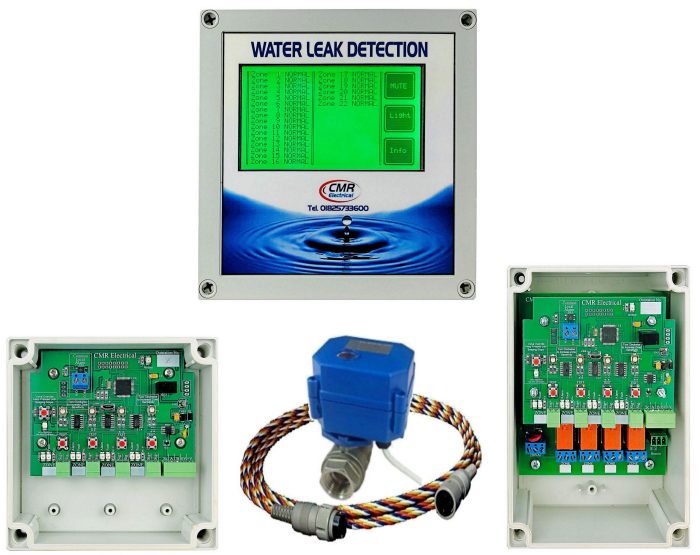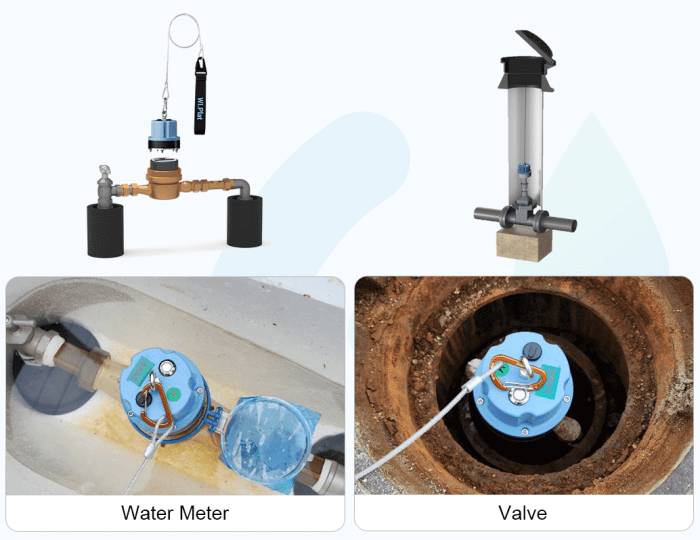Flood and leak sensors are increasingly vital for protecting homes from costly water damage. These unsung heroes quietly monitor for leaks and floods, providing early warnings that can prevent significant financial losses and property damage. From simple, affordable models to sophisticated smart home integrated systems, a wide range of options cater to various needs and budgets. Understanding the different types, installation methods, and integration possibilities is key to choosing the right system for your home’s unique requirements.
This guide explores the world of flood and leak sensors, covering everything from the various technologies available to the best practices for installation and maintenance. We’ll delve into how these sensors integrate with smart home systems, enhancing security and providing peace of mind. We’ll also look at the cost considerations and the potential return on investment, helping you make informed decisions about protecting your most valuable asset: your home.
Types of Flood and Leak Sensors
Choosing the right flood and leak sensor depends heavily on the specific application and the environment where it will be deployed. Different sensor technologies offer varying levels of accuracy, reliability, and cost-effectiveness. Understanding these differences is crucial for effective water damage prevention.
Several types of sensors are commonly used to detect floods and leaks. Each utilizes a different physical principle to measure the presence of water. The choice depends on factors like the sensitivity required, the environment’s characteristics (e.g., presence of dust or debris), and the budget.
Sensor Type Comparison
The following table summarizes the key characteristics of various flood and leak sensor types. Note that the pros and cons are relative and depend on the specific application and sensor model.
| Sensor Type | Detection Method | Pros | Cons |
|---|---|---|---|
| Ultrasonic | Measures the time it takes for an ultrasonic pulse to reflect off a water surface. | Relatively inexpensive; can detect water at a distance; not affected by water conductivity. | Accuracy can be affected by air temperature and humidity; susceptible to interference from other ultrasonic sources; may not detect small leaks effectively. |
| Capacitive | Measures changes in capacitance caused by the presence of water (water has a high dielectric constant). | Highly sensitive to small amounts of water; relatively inexpensive; compact size. | Can be affected by changes in temperature and humidity; susceptible to contamination; may not be suitable for high-pressure applications. |
| Resistive | Detects changes in electrical resistance caused by the presence of water (water conducts electricity). | Simple and inexpensive; highly reliable for detecting direct contact with water. | Requires direct contact with water; susceptible to corrosion; may not be suitable for applications where submersion is likely. |
| Conductive | Uses two conductive probes; when water bridges the gap between them, a current flows, indicating a leak. | Simple, reliable, and inexpensive; directly detects the presence of water. | Requires direct contact with water; susceptible to corrosion; may be less sensitive than capacitive sensors. |
Sensor Applications
The suitability of each sensor type depends heavily on the specific application. The following examples illustrate some common use cases.
- Ultrasonic Sensors: Ideal for detecting larger floods in basements or crawl spaces, where a non-contact sensing method is preferred. For example, they can be placed in a corner to monitor rising water levels.
- Capacitive Sensors: Well-suited for detecting small leaks in appliances or under sinks, where high sensitivity is crucial. They are often integrated into washing machines or dishwashers to detect leaks promptly.
- Resistive Sensors: Best used in applications requiring direct contact with water, such as in sump pumps or as part of a floor mat system to detect standing water.
- Conductive Sensors: Commonly used in simple leak detection systems, such as those in water heaters or pipes. A basic leak detection system for a water heater might use two conductive probes attached to the bottom of the heater.
Accuracy and Reliability
The accuracy and reliability of flood and leak sensors vary significantly depending on the sensor type and environmental conditions. Capacitive sensors generally offer higher sensitivity and can detect smaller leaks more reliably than ultrasonic sensors. However, their performance can be affected by temperature and humidity fluctuations. Resistive sensors are generally very reliable when water is in direct contact but are less sensitive to smaller leaks.
Ultrasonic sensors are less sensitive to small leaks but can operate in more challenging environments.
In practice, the reliability of any sensor is also influenced by factors such as sensor placement, calibration, and the quality of the sensor itself. Regular testing and maintenance are crucial for ensuring the continued accuracy and reliability of any flood or leak detection system.
Sensor Placement and Installation

Source: familyhandyman.com
Proper placement and installation of flood and leak sensors are crucial for effective water damage detection. Strategic positioning maximizes their ability to alert you to leaks before significant damage occurs, saving you time, money, and stress. Understanding the potential water sources in your home and the environmental conditions that might affect sensor performance is key to a successful installation.
Choosing the right location for your sensors involves considering several factors. The proximity to potential water sources is paramount. You also need to account for environmental conditions like temperature and humidity, which can impact sensor accuracy and longevity. Finally, the accessibility of the sensors for testing and maintenance should be a factor in your decision.
Best Practices for Sensor Placement in Various Locations, Flood and leak sensors
Proper placement varies depending on the area of your home. Following these guidelines will help ensure optimal performance and early detection of leaks.
Flood and leak sensors are a great addition to any home, offering peace of mind against water damage. These sensors often integrate seamlessly with your Smart home networks , sending alerts directly to your phone. This means you can get immediate notification of a leak, even if you’re away from home, allowing for quicker response times and potentially preventing significant damage.
Ultimately, flood and leak sensors are a smart investment for protecting your property.
- Basements: Install sensors near sump pumps, water heaters, washing machines, and any pipes or plumbing fixtures. Consider placing sensors in corners where water might pool. Avoid placing them directly on the floor in areas prone to flooding; elevated placement is ideal.
- Bathrooms: Place sensors under sinks, near toilets, and in shower areas. Consider sensors behind toilets and under vanities where leaks are common but often hidden.
- Kitchens: Install sensors under sinks, near dishwashers, and refrigerators (especially if ice makers are present). Monitor areas prone to spills or leaks around the plumbing.
- Other Areas: Consider placing sensors near appliances like washing machines, water softeners, and humidifiers in any location.
Factors to Consider When Choosing Sensor Placement
Several factors influence the effectiveness of your flood and leak sensors. Careful consideration of these factors will lead to a more robust and reliable system.
- Proximity to Water Sources: Sensors should be placed as close as possible to potential leak points, but not directly in areas where they might be submerged.
- Environmental Conditions: Extreme temperatures, high humidity, and dust can affect sensor performance. Choose locations with moderate temperatures and good ventilation.
- Accessibility: Sensors should be easily accessible for testing, maintenance, and battery replacement.
- Sensor Type: Different sensors have different capabilities and installation requirements. Follow the manufacturer’s instructions for optimal placement.
Diagram of Optimal Sensor Placement in a Typical Residential Home
Imagine a two-story house. The basement shows sensors near the sump pump, water heater, and washing machine. In the kitchen, sensors are placed under the sink and near the dishwasher. Bathrooms on both floors have sensors under sinks and near toilets. Additional sensors are placed near any other potential water sources, such as a water softener or humidifier.
The diagram visually represents a comprehensive network of sensors strategically positioned to provide early warning of leaks throughout the house. The sensors are shown as small icons, clearly labeled and placed in relation to the key water sources in each room. Lines connect the sensors to a central monitoring hub, indicating how the system is interconnected. The diagram clearly illustrates the importance of multiple sensor placements for complete coverage.
Integration with Smart Home Systems
Flood and leak sensors significantly enhance smart home functionality by providing real-time data on potential water damage. This integration allows for proactive responses, minimizing damage and preventing costly repairs. By connecting to popular smart home platforms, these sensors become integral parts of a comprehensive home security and automation system.Integrating flood and leak sensors into your smart home ecosystem offers a layer of protection beyond basic monitoring.
The data collected by these sensors can be used to trigger automated responses, send alerts, and even integrate with other smart devices to create a truly connected and secure home environment. This proactive approach to water damage prevention offers significant peace of mind and potential cost savings.
Smart Home Platform Integration
Flood and leak sensors readily integrate with major smart home platforms like Google Home, Amazon Alexa, and Apple HomeKit. This integration typically involves connecting the sensor to the platform’s app, following the manufacturer’s instructions. Once connected, the sensor’s data – such as water detection – becomes accessible through the app, enabling users to monitor their home’s status remotely. For example, a user might receive a notification on their smartphone if a leak is detected in the basement, even if they are away from home.
This real-time monitoring capability is a key advantage of smart home integration.
Automated Responses to Sensor Data
The real power of smart home integration lies in automation. When a flood or leak sensor detects water, it can trigger pre-programmed responses. This might involve automatically shutting off a connected water valve, preventing further water damage. Some systems can even integrate with smart lighting, turning on lights in the affected area to increase visibility. Another example is sending alerts to multiple users via SMS or email, ensuring that someone is notified regardless of their location.
This proactive approach can significantly mitigate the effects of a leak or flood.
Flood and leak sensors offer crucial early warning for water damage, protecting your home from costly repairs. But for a complete picture of potential home emergencies, integrating them with a robust security system is key. Consider adding Home surveillance cameras to visually monitor areas prone to leaks, providing further evidence for insurance claims or simply offering peace of mind.
This combined approach ensures comprehensive protection against water damage.
Benefits of Integration within a Home Security and Automation System
Integrating flood and leak sensors into a broader home security and automation system offers numerous benefits. For example, combining them with security cameras can provide visual confirmation of a leak, aiding in assessment and response. Integration with smart locks could allow for remote access to the property in case of a significant water event requiring immediate attention. The comprehensive nature of such a system allows for a more coordinated and effective response to potential water damage, minimizing disruption and financial loss.
Imagine a scenario where a sensor detects a leak, automatically shuts off the main water valve, sends an alert to your phone, and activates a smart camera to provide visual confirmation. This automated response chain is a powerful illustration of the benefits of seamless integration.
Data Analysis and Alert Systems
Flood and leak sensors generate valuable data that, when properly analyzed, can provide crucial insights into potential water damage. Effective data processing and interpretation are key to minimizing damage and preventing costly repairs. Alert systems play a critical role in this process, ensuring timely notification of potential issues.Data from flood and leak sensors typically includes sensor readings (e.g., water level, conductivity), timestamps, and sensor location.
This raw data needs processing to identify significant events, differentiating between actual leaks and false positives caused by factors like condensation or minor spills. Sophisticated systems might employ machine learning algorithms to analyze historical data and predict potential leak locations based on patterns and anomalies. Simpler systems rely on threshold-based triggers – if a sensor reading exceeds a predefined value, an alert is generated.
Alert System Mechanisms
Different methods exist for delivering alerts, each with its own advantages and disadvantages. The choice of alert system depends on factors like user preferences, budget, and the level of automation desired.
| Alert Type | Method of Delivery | Advantages | Disadvantages |
|---|---|---|---|
| Email Notification | Email message sent to registered addresses | Reliable, detailed information can be included, accessible from various devices. | May be delayed, requires internet connectivity, can be easily overlooked amongst other emails. |
| Mobile App Alert | Push notification sent to a smartphone app | Immediate notification, convenient access, can include location information and images. | Requires app installation and smartphone access, relies on network connectivity, app-specific limitations. |
| Audible Alarm | Loud siren or buzzer activated locally | Immediate, attention-grabbing, doesn’t require network connectivity. | Can be annoying, limited range, may not be suitable for all environments. |
| SMS Alert | Text message sent to a mobile phone | Wide reach, generally reliable, doesn’t require internet access (only mobile data). | Limited character count for detailed information, may incur charges. |
Designing an Effective Alert System
Designing an effective alert system involves a balance between sensitivity and specificity. The system should be sensitive enough to detect actual leaks promptly, while minimizing false positives that trigger unnecessary alerts and lead to user apathy. This can be achieved through several strategies:* Calibration and Testing: Regular calibration of sensors and testing of the alert system ensures accurate readings and timely responses.
This involves periodically checking sensor readings against known conditions to identify and correct any discrepancies.* Threshold Adjustment: Carefully setting appropriate thresholds for triggering alerts is crucial. This involves analyzing historical data and adjusting the thresholds based on environmental conditions and sensor characteristics to minimize false positives. For example, a higher threshold might be set for sensors in humid basements to avoid triggering alerts due to condensation.* Multiple Sensor Confirmation: Utilizing multiple sensors to confirm a leak before triggering an alert enhances the reliability of the system.
Flood and leak sensors are crucial for protecting your home from water damage, especially in areas like kitchens and bathrooms. The placement of these sensors can be influenced by your cabinetry, so considering the design of your cabinets is important. For instance, if you’re planning a kitchen remodel, check out some stylish options for cabinet door designs to see how they might impact sensor placement.
Ultimately, effective sensor placement is key to preventing costly water damage.
This reduces the likelihood of false positives caused by a single malfunctioning sensor. For example, two sensors detecting a leak in the same area would confirm the event.* Data Filtering and Smoothing: Applying data filtering techniques, such as moving averages, can help to smooth out noisy sensor readings and reduce the number of false positives caused by temporary fluctuations.* User-Configurable Alert Settings: Allowing users to customize alert settings, such as sensitivity levels and notification methods, ensures the system meets their individual needs and preferences.
This personalization allows users to tailor the system’s responsiveness to their specific environment and risk tolerance.
Maintenance and Troubleshooting

Source: cmrelectrical.com
Keeping your flood and leak sensors in top condition is crucial for protecting your property. Regular maintenance ensures they’ll alert you to potential problems promptly, preventing costly water damage. Neglecting maintenance can lead to false alarms, missed detections, or complete sensor failure. This section Artikels a recommended maintenance schedule and troubleshooting steps to maximize the lifespan and accuracy of your sensors.
Flood and leak sensors are crucial for preventing costly water damage. For optimal protection, consider installing these sensors within your valuable equipment housed in secure locations, like inside Modular cabinets , which offer added protection from the elements. This ensures early detection and minimizes disruption, safeguarding both your belongings and the cabinets themselves from water damage.
A proactive approach to maintenance will significantly improve the reliability and longevity of your flood and leak detection system. This includes both regular checks and prompt attention to any issues that arise.
Regular Maintenance Schedule
Establishing a routine maintenance schedule ensures your sensors remain vigilant. The frequency of checks will depend on the specific sensor type and your environment (e.g., a sensor in a high-humidity basement might need more frequent attention than one in a dry, climate-controlled room). However, a general guideline is helpful to start with.
- Monthly Inspection: Visually inspect each sensor for any signs of damage, such as cracks, loose connections, or corrosion. Check the battery level (if applicable) and ensure the sensor is securely mounted.
- Quarterly Test: Perform a test of each sensor to verify its functionality. This might involve simulating a leak (with a small amount of water) or using the sensor’s built-in test function (if available). Record the results of these tests.
- Annual Cleaning: Gently clean the sensor’s probes or contact points with a soft, dry cloth. Avoid using harsh chemicals or abrasive cleaners that could damage the sensor. For sensors with external covers, remove and clean these as well.
- Battery Replacement (as needed): Replace batteries according to the manufacturer’s recommendations. Note the date of battery replacement to help track future replacements.
Common Problems and Solutions
While flood and leak sensors are generally reliable, certain problems can occur. Understanding these common issues and their solutions can save you time and potential damage.
Flood and leak sensors offer crucial peace of mind, especially in preventing costly water damage. These are just one example of the many helpful smart home devices available; for more ideas on improving safety and convenience, check out this guide on Home tech for seniors. Early detection from flood and leak sensors can prevent significant problems and protect your home from water-related damage.
| Problem | Solution |
|---|---|
| False Alarms | Check for condensation, dust, or debris on the sensor. Ensure proper sensor placement to avoid triggering from normal humidity changes. Consider recalibrating the sensor. |
| Missed Detections | Verify the sensor is properly powered and connected. Inspect the sensor for any physical damage. Check the sensor’s placement to ensure it’s in an optimal location for leak detection. Consider recalibrating or replacing the sensor. |
| Sensor Malfunction | Try replacing the batteries. If the problem persists, check all wiring connections. If the problem continues, the sensor may need replacement. |
| Low Battery Warning | Replace the batteries promptly. Failure to do so can result in missed detections. |
Importance of Regular Testing and Calibration
Regular testing and, where applicable, calibration are vital for maintaining the accuracy and reliability of your flood and leak sensors. Testing confirms that the sensors are functioning correctly and can detect leaks as intended. Calibration, where supported by the sensor, ensures that the sensor’s readings are accurate and consistent over time. Ignoring these steps can lead to false alarms or, more critically, missed detections that could result in significant water damage.
For example, a sensor that hasn’t been tested in a year might fail to detect a small leak, leading to extensive water damage before an alert is triggered. Regular testing and calibration, however, significantly reduce this risk, ensuring your system remains a reliable guardian against water damage.
Cost Considerations and ROI
Investing in flood and leak sensors might seem like an added expense, but considering the potential for significant water damage, it’s a worthwhile investment to protect your property. The cost of sensors varies greatly depending on features, brand, and the number of sensors needed, while the potential return on investment comes from preventing costly repairs and mitigating the disruption caused by water damage.The initial cost of purchasing and installing flood and leak sensors is a significant factor.
However, comparing this upfront cost to the potential cost of water damage repair reveals a compelling case for the sensors’ value.
Flood and Leak Sensor Pricing Comparison
The market offers a wide range of flood and leak sensors, each with varying price points and features. The following table provides a comparison of some popular models. Note that prices can fluctuate based on retailer and sales.
| Brand | Model | Price (USD, approximate) | Key Features |
|---|---|---|---|
| Flo by Moen | Smart Water Shutoff | $400 – $500 | Automatic water shutoff, leak detection, app integration, remote monitoring |
| Philips Hue | Smart Water Sensor | $40 – $60 | Leak detection, app notifications, integration with other smart home devices |
| D-Link | Wireless Water Sensor | $20 – $30 | Leak detection, wireless connectivity, battery powered |
| Honeywell | Wireless Water Leak Detector | $30 – $40 | Leak detection, local alarm, wireless connectivity |
Return on Investment (ROI) of Flood and Leak Sensors
The ROI of flood and leak sensors is determined by comparing the cost of the sensors and installation to the potential cost of water damage repair. A small leak, undetected, can lead to thousands of dollars in repairs, including drywall replacement, flooring repair, and mold remediation. For example, a minor leak behind a washing machine, left undetected, could easily cause $5,000 – $10,000 in damage.
The cost of a single sensor, even a smart system, is significantly less than the cost of repairing such damage. Furthermore, the disruption caused by water damage – the need to relocate, the time spent on repairs, and the emotional stress – is difficult to quantify but adds significantly to the overall cost. The peace of mind provided by knowing you have a system in place to detect and alert you to leaks far outweighs the initial investment.
Cost Comparison: Sensor Installation vs. Water Damage Repair
Let’s consider a hypothetical scenario: A homeowner installs a system of four leak sensors for a total cost of $150 (including installation). A small leak goes undetected in their bathroom, resulting in damage to the subfloor and drywall. The repair cost, including labor and materials, could easily reach $3,000 or more. In this case, the ROI is clear: the $150 investment prevented a far greater expense.
Even in the absence of a major leak, the sensors provide a substantial return by preventing smaller, more frequent issues from escalating into significant problems. Consider a scenario where a dripping faucet is detected early, saving the cost of water waste and potential damage to surrounding areas. The long-term cost savings and the protection of valuable assets easily justify the upfront investment in flood and leak sensors.
Last Recap

Source: wiplat.com
Protecting your home from water damage is a critical investment, and flood and leak sensors offer a cost-effective and proactive solution. By understanding the different types of sensors, optimal placement strategies, and integration capabilities with smart home systems, you can significantly reduce the risk of costly water damage and enjoy the peace of mind that comes with knowing your home is protected.
Choosing the right system, coupled with regular maintenance, ensures the long-term effectiveness of these vital safeguards, providing valuable protection for years to come. Don’t wait for a disaster – invest in flood and leak sensors today.
FAQ Explained: Flood And Leak Sensors
How long do flood and leak sensors typically last?
The lifespan varies depending on the brand and model, but many sensors last for several years with proper maintenance.
What is the difference between a flood sensor and a leak sensor?
Flood sensors detect standing water, while leak sensors detect the presence of water in a specific location, often indicating a leak before it becomes a flood.
Can flood and leak sensors be used outdoors?
Some sensors are designed for outdoor use, but most are intended for indoor applications. Check the manufacturer’s specifications before using a sensor outdoors.
What should I do if my flood sensor goes off but there’s no visible water?
Check for hidden leaks, condensation, or potential sensor malfunction. Test the sensor and contact the manufacturer if necessary.
Are battery-powered sensors more reliable than wired ones?
Both have their pros and cons. Battery-powered sensors are easier to install but require battery replacements, while wired sensors offer continuous power but require more complex installation.



